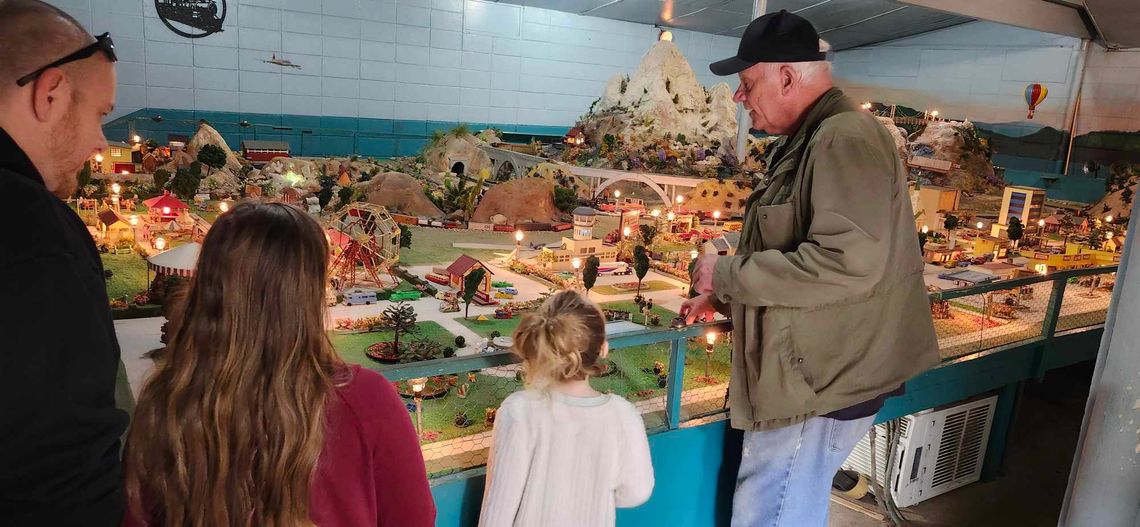Over Spring Break, we took a family road trip to Hot Springs, Arkansas. While the city’s wax museum, natural spring fountains and historic bath houses are all great, our favorite tourist attraction there is Tiny Town.
Tiny Town began as a hobby in the 1930s by then-teenager Frank Moshinskie, who used modeling clay and recycled items he had lying around the house (tin cans, bottle caps, match sticks, etc.) to handcraft a miniature village that he displayed beneath the family Christmas tree each holiday season.
Over the years, he continued to build onto the creation, and today Tiny Town fills a 1,000 square-foot building and attracts tourists from all over the country.
For just $6 a person ($4 for kids), visitors can tour the massive diorama which features famous landmarks like Mount Rushmore and Niagara Falls as well as miniature animals and people (including celebrities like Dolly Parton and Elvis Presley).
A plumber by trade, Moshinskie included running water features in the display as well as working electricity that turns on street lamps and house lights (a powerful sight when the overhead lights are turned off for visitors to admire the town “at night”). Model trains also run throughout the display.
Perhaps more impressive than the handiwork and creativity it took to build Tiny Town is the sheer love and admiration in the voice of tour guide Charles (Moshinskie’s now-elderly son) who describes the process and details of the town with great care.
Seeing Tiny Town through the eyes of my daughters reminded me of when my husband and I took a three-month honeymoon road trip across the country, visiting all 48 contiguous states. We called it our “Looking for America” tour and saw the absolute best (and, admittedly, some of the worst) that our nation has to offer.
While the varying scenery and interesting people were definite highlights of the trip, what really stood out to me was the creativity, fortitude and ingenuity of the American people – especially those in small towns.
In Regent, North Dakota (population less than 200), we stumbled upon the Enchanted Highway, 32 miles of two-lane road that features the world’s largest scrap-metal sculptures. When artist Gary Greff realized that population and economic decline were negatively impacting his hometown, he knew he had to do something to help revive his community.
In 1989, he began creating a series of metal sculptures to help put his town back on the map. The sculptures range from historical figures to whimsical scenes, and they now attract nearly 6,000 cars a year to his small town.
Then there was Farmer James in Missouri. We stopped at his rural shop for some fresh pecans and struck up a conversation with him, chatting about our road trip and his pecan farm. Then we asked about a sign we had seen out front for “Wham & Petey: The Harvest” which featured cartoon characters of a hammer and a pecan.
Farmer James explained that pecan farming was important to the community, but newer generations were losing interest. He had wanted to find a way to teach children about the industry so he had created a children’s show starring Wham the hammer and Petey the pecan. Encouraged by our interest, he asked if we’d like to see it.
He led us to a barn that he had turned into a small, homemade theater – up front was a stage where he presented the show, and wooden benches served as theater seating. Giant wooden, motorized characters came to life to a recorded soundtrack and we sat and enjoyed a free viewing of the Wham & Petey show.
Farmer James had written the songs, recorded the music and built the set. He had even turned the whole story into a children’s book (which he now sells on his website). His goal was for schools to bring kids on field trips, but also to take the show on the road and reach as many children as possible to help promote the pecan farm industry. And that’s just what he did.
Stories like these can be found all over the country. That honeymoon road trip took place nearly 20 years ago, and I still think about those people to this day – small-town folks with big ideas who wanted to do something to make a difference in their community.
Now we’re doing our part by taking our kids to see those inspirational ideas and showing our girls that they, too, can make a difference in their small town.
Anyone can go to the big theme park or renowned museum in the big cities. But have you ever seen the world’s largest ball of twine in Kansas; the Corn Palace in South Dakota; or the Coral Castle in Florida?
As you make your travel plans this summer, I encourage you to seek out the towns and tourist attractions that are off the beaten path. That’s where you’ll really see the heart and soul of our country. That’s where you should go if you’re “Looking for America.”

